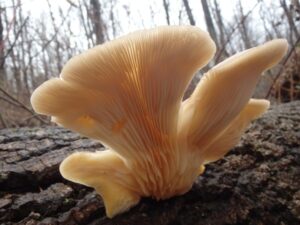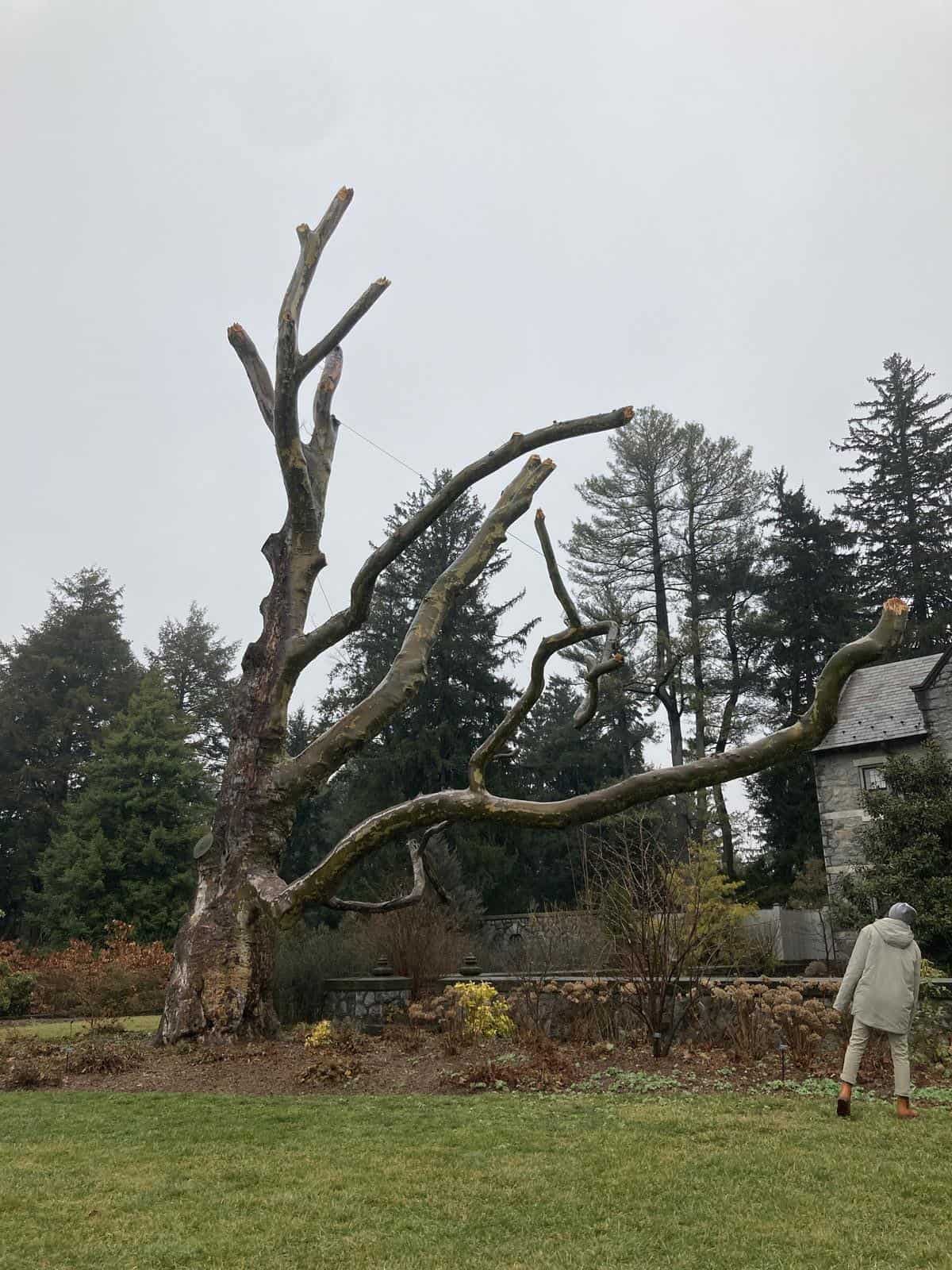Heartwood.
February 27, 2023
The Main House at Stoneleigh peeks behind the limbs of a large plane tree with bright green leaves.
At Stoneleigh: a natural garden, a magnificent London planetree towers near the Main House like a living picture frame. Although we don’t have any specific records of its planting date, this tree is estimated to be at least 150 years old. Photographs from 1913 show the tree standing dozens of feet tall. It has become a familiar sight over the years as guests explore Stoneleigh. Students have written poems about its branches, and many people have enjoyed a seat under the canopy of its leaves.
Sadly, the London planetree is dying. This tree has sycamore anthracnose, a fungal disease that affects a tree’s ability to leaf out, thereby affecting its ability to photosynthesize. It also has sycamore canker stain, a more serious, frequently fatal pathogen caused by a different fungus. The tree was already in decline when Natural Lands acquired Stoneleigh in 2016. Our staff and expert arborists have been attending to it over the years, pruning dying branches, but we now must accept that the life of this tree is ending.
For the safety of our guests and to protect the historic structures on the property, we needed to scale back the tree. Arborists from Shreiner Tree Care removed most of the branches and topped the tree, leaving the central trunk, called a snag. This will prevent injury or damage from falling branches. It will also allow the tree to continue to play a part in the ecosystem of the garden.
 When a tree dies, its death can serve a purpose as vital as its life. As the tree is dying, some insects, such as metallic jewel beetles, move into the tree creating tunnels and openings for fungal spores and bacteria. Over time, the central part of the wood core of the tree, known as the heartwood, will begin to soften. As the heartwood decays, more insects arrive, burrowing and building, while woodpeckers tap on the softening wood to feast on the bugs. Mammals crawl into open holes, taking shelter in the heartwood against the winter’s chill or building nests to rear their young in spring. Native mushrooms sprout from the bark like open fans in orange and white. New plant species thrive in the newly available sunshine, offering food and shelter for myriad species.
When a tree dies, its death can serve a purpose as vital as its life. As the tree is dying, some insects, such as metallic jewel beetles, move into the tree creating tunnels and openings for fungal spores and bacteria. Over time, the central part of the wood core of the tree, known as the heartwood, will begin to soften. As the heartwood decays, more insects arrive, burrowing and building, while woodpeckers tap on the softening wood to feast on the bugs. Mammals crawl into open holes, taking shelter in the heartwood against the winter’s chill or building nests to rear their young in spring. Native mushrooms sprout from the bark like open fans in orange and white. New plant species thrive in the newly available sunshine, offering food and shelter for myriad species.

The London planetree after the process of scaling down. Vines will be planted around the base of the tree in the spring. Photo by Sam Nestory
Our beloved London planetree will still be a part of the garden. This spring, staff will plant a selection of native vines at the base of the tree, including American wisteria, which has impressive lavender blooms. These vines will be trained up the tree and along the remaining limbs over the next several years, creating a beautiful floral display every spring. The reduced canopy will also provide an opportunity to add more sun-loving native plants to the surrounding garden spaces, which will increase the biodiversity in this area.
The London planetree is a hybrid of the American sycamore. While it shares many traits of the sycamore, it is not a native species to our region. This transition will allow us to plant a variety of native, sun-loving species in the absence of the once dense and leafy canopy, a continuation of our commitment to planting native species as nonnative plants come to the end of their lifecycle.
Every gardener knows that change is part of tending a garden. In nature, endings are intimately tied with beginnings, decay nurtures new growth. We invite you to visit to see our progress this spring as we transform the tree to a snag, and to come back to watch how we grow, change, and bloom.
next post
Crow's Nest Scat Lab
January 27, 2023
By Molly Smyrl, Environmental Educator. How do you get a group of High School students excited to learn about animal scat? By having them make […]
continue reading